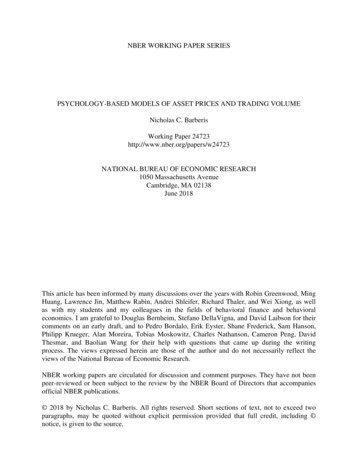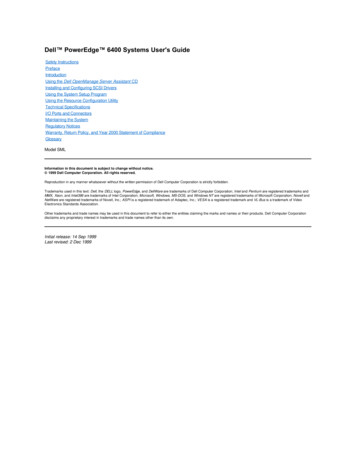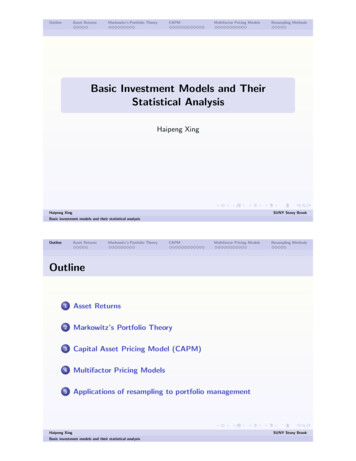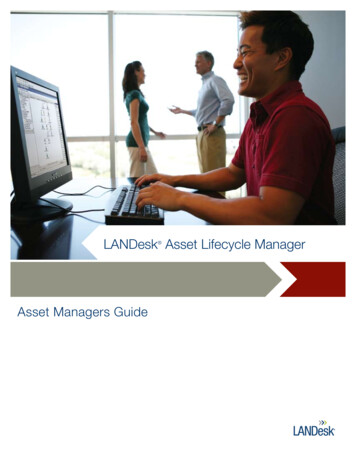
Transcription
NBER WORKING PAPER SERIESPSYCHOLOGY-BASED MODELS OF ASSET PRICES AND TRADING VOLUMENicholas C. BarberisWorking Paper 24723http://www.nber.org/papers/w24723NATIONAL BUREAU OF ECONOMIC RESEARCH1050 Massachusetts AvenueCambridge, MA 02138June 2018This article has been informed by many discussions over the years with Robin Greenwood, MingHuang, Lawrence Jin, Matthew Rabin, Andrei Shleifer, Richard Thaler, and Wei Xiong, as wellas with my students and my colleagues in the fields of behavioral finance and behavioraleconomics. I am grateful to Douglas Bernheim, Stefano DellaVigna, and David Laibson for theircomments on an early draft, and to Pedro Bordalo, Erik Eyster, Shane Frederick, Sam Hanson,Philipp Krueger, Alan Moreira, Tobias Moskowitz, Charles Nathanson, Cameron Peng, DavidThesmar, and Baolian Wang for their help with questions that came up during the writingprocess. The views expressed herein are those of the author and do not necessarily reflect theviews of the National Bureau of Economic Research.NBER working papers are circulated for discussion and comment purposes. They have not beenpeer-reviewed or been subject to the review by the NBER Board of Directors that accompaniesofficial NBER publications. 2018 by Nicholas C. Barberis. All rights reserved. Short sections of text, not to exceed twoparagraphs, may be quoted without explicit permission provided that full credit, including notice, is given to the source.
Psychology-based Models of Asset Prices and Trading VolumeNicholas C. BarberisNBER Working Paper No. 24723June 2018JEL No. G11,G12,G40ABSTRACTBehavioral finance tries to make sense of financial data using models that are based onpsychologically accurate assumptions about people's beliefs, preferences, and cognitive limits. Ireview behavioral finance approaches to understanding asset prices and trading volume, withparticular emphasis on three types of models: extrapolation-based models, models ofoverconfident beliefs, and models of gain-loss utility inspired by prospect theory. The research todate shows that a few simple assumptions about investor psychology capture a wide range offacts about prices and volume and lead to concrete new predictions. I end by speculating aboutthe form that a unified psychology-based model of investor behavior might take.Nicholas C. BarberisYale School of Management135 Prospect StreetP O Box 208200New Haven, CT 06520-8200and NBERnick.barberis@yale.edu
Contents1 Introduction42 Empirical facts62.1Aggregate asset classes . . . . . . . . . . . . . . . . . . . . . . . . . . . . . .62.2The cross-section of average returns . . . . . . . . . . . . . . . . . . . . . . .82.3Bubbles . . . . . . . . . . . . . . . . . . . . . . . . . . . . . . . . . . . . . .113 Limits to arbitrage124 Beliefs: Extrapolation164.1Return extrapolation . . . . . . . . . . . . . . . . . . . . . . . . . . . . . . .164.2Extrapolation of fundamentals . . . . . . . . . . . . . . . . . . . . . . . . . .244.3Sources of extrapolative beliefs . . . . . . . . . . . . . . . . . . . . . . . . . .264.4Experience effects . . . . . . . . . . . . . . . . . . . . . . . . . . . . . . . . .314.5Extrapolative beliefs: Summary . . . . . . . . . . . . . . . . . . . . . . . . .335 Beliefs: Overconfidence5.134Disagreement with a short-sale constraint . . . . . . . . . . . . . . . . . . . .6 Other belief-based approaches37406.1Sticky beliefs . . . . . . . . . . . . . . . . . . . . . . . . . . . . . . . . . . .406.2Models of under- and over-reaction . . . . . . . . . . . . . . . . . . . . . . .426.3Beliefs about rare events . . . . . . . . . . . . . . . . . . . . . . . . . . . . .446.4Feelings and beliefs . . . . . . . . . . . . . . . . . . . . . . . . . . . . . . . .456.5Herding and social interaction . . . . . . . . . . . . . . . . . . . . . . . . . .466.6Psychology-free approaches . . . . . . . . . . . . . . . . . . . . . . . . . . . .487 Preferences: Gain-loss utility and prospect theory507.1The elements of prospect theory . . . . . . . . . . . . . . . . . . . . . . . . .517.2Prospect theory and the cross-section: Static models . . . . . . . . . . . . .567.3Prospect theory and the cross-section: Dynamic models . . . . . . . . . . . .592
7.4Prospect theory and the aggregate stock market . . . . . . . . . . . . . . . .627.5Prospect theory applications: Summary . . . . . . . . . . . . . . . . . . . . .667.6Other alternatives to Expected Utility . . . . . . . . . . . . . . . . . . . . .678 Preferences: Ambiguity aversion699 Bounded rationality729.1Inattention. . . . . . . . . . . . . . . . . . . . . . . . . . . . . . . . . . . .749.2Categorization . . . . . . . . . . . . . . . . . . . . . . . . . . . . . . . . . . .7510 Discussion and Conclusion7711 Appendix8012 References813
1IntroductionThe modern era of finance research began in the 1950s with the work of Markowitz (1952)on portfolio choice and Modigliani and Miller (1958) on capital structure. For the next fourdecades, research in finance – especially research on asset prices – was dominated by a singleframework, the “traditional” framework, which is based on two assumptions about individualpsychology. The first is that people have rational beliefs: when new information arrives, theyimmediately update their beliefs about future outcomes, and do so correctly, as prescribedby Bayes’ rule. The second is that they make decisions according to Expected Utility: giventheir beliefs, they choose the action with the highest Expected Utility for a utility functionthat is defined over consumption outcomes and that is increasing and concave.In the 1980s, a new paradigm, behavioral finance, began to emerge. Its goal is to makesense of facts in finance using models that are psychologically more realistic than those thatcame before. The field has grown rapidly over the past 30 years. In this article, I reviewresearch in behavioral finance, focusing on applications to asset prices and trading volume.1Research in behavioral finance has tried to improve the psychological realism of thetraditional model along three dimensions. First, through more realistic assumptions aboutindividual beliefs – in particular, that people do not update their beliefs in a fully rationalmanner, thereby deviating from Bayes’ rule. Second, through more realistic assumptionsabout individual preferences – for example, by rethinking what it is that people deriveutility from and what form their utility function takes, or by replacing Expected Utility withan alternative framework such as prospect theory. And third, by taking account of cognitivelimits – by recognizing that people are unlikely to be able to immediately process all of theinformation that is relevant to their financial situation, given how much information of thiskind arrives every week. This article is structured around these three dimensions: I review,in turn, models of beliefs, models of preferences, and models of cognitive limits.Why did behavioral finance emerge when it did, in the 1980s, and then gather steamin the 1990s? At least three factors played a role. First, by the late 1980s, there was agrowing sense that some basic facts about financial markets were hard to reconcile with thetraditional finance framework. In a 1981 paper – a paper seen by many as the starting pointof modern behavioral finance – Robert Shiller argued that fluctuations in stock market pricesare unlikely to be the result of rationally-varying forecasts of firms’ future cash flows. Otherpapers, among them De Bondt and Thaler (1985), showed that some investment strategiesearn average returns that are higher than can be justified by simple measures of risk. Inthe view of many researchers, these findings called for a new generation of models – for1The models of asset prices and volume that I discuss also make predictions about individual portfoliochoice, but I do not cover that topic in much detail; for a fuller treatment of it, see Guiso and Sodini (2013)and Beshears et al. (2018). For behavioral finance approaches to corporate finance, see Baker and Wurgler(2012) and Malmendier (2018). For other surveys of psychology-based models of asset prices, see Shleifer(2000), Hirshleifer (2001), and Barberis and Thaler (2003).4
example, models that allow for less than fully rational beliefs – and this spurred the growthof behavioral finance. The technology stock mania of the late 1990s and the more recent realestate boom and subsequent financial crisis brought additional attention to the field.A second factor is the work on limits to arbitrage in the 1990s. An old critique ofbehavioral finance, the “arbitrage critique,” posits that irrational investors cannot have asubstantial and long-lived impact on the price of an asset, because, if they did, this wouldcreate an attractive opportunity for rational investors who would trade aggressively againstthe mispricing and remove it. This argument proved compelling to economists for many yearsand slowed the development of behavioral finance. In the 1990s, however, some researcherspushed back against the arbitrage critique, noting that, in reality, rational traders face risksand costs that limit their ability to correct a mispricing (De Long et al., 1990a; Shleifer andVishny, 1997). This work on limits to arbitrage, which I discuss in more detail later, hasbeen influential and was an important factor in the rise of behavioral finance.The third reason for the growth of behavioral finance in the 1990s was the dramaticprogress in the 1970s and 1980s in an area of psychology known as “judgment and decisionmaking.” This field, which was dominated for years by Daniel Kahneman and Amos Tversky,seeks to paint a more realistic picture of how people form beliefs and make decisions. Forfinancial economists who were looking for guidance on how to make their models morepsychologically accurate, this research was invaluable. Much of the conceptual progress inbehavioral finance over the past 30 years has come from incorporating ideas from the fieldof judgment and decision-making into more traditional finance models.Behavioral finance research on asset prices has an ambitious agenda. It argues that thetraditional model does not offer a complete account of even the most basic aspects of the data– facts about asset market fluctuations, average returns on asset classes, trading volume, andbubbles – and that a behavioral finance perspective is essential for a full understanding of theevidence. On some dimensions, behavioral finance can already claim success: it has shownthat models based on a few simple assumptions about individual psychology can explain awide range of empirical facts, and can make concrete, testable predictions, some of whichhave already been confirmed in the data.As indicated above, this article is organized around the three approaches researchers havetaken to develop psychologically realistic models of investor behavior. In Sections 4 through6, I review models based on more psychologically accurate assumptions about individualbeliefs; the main ideas here are extrapolation and overconfidence. In Sections 7 and 8,I discuss models that focus on individual preferences; the key concepts here are gain-lossutility and prospect theory, and ambiguity aversion. And in Section 9, I cover models thattake into account people’s cognitive limits. In Section 10, I evaluate progress in the fieldand conclude. Before embarking on the discussion of behavioral finance models in Section4, I first cover two important background topics. In Section 2, I review the main empiricalfacts that are the focus of study in the field of asset prices. In Section 3, I summarize theresearch on limits to arbitrage and relate the themes of this article to the concept of “efficient5
markets.”Over the years, researchers in behavioral finance have pursued a number of differentpsychology-based approaches. One might therefore worry that the field consists of manyscattered ideas. Fortunately, this is not the case. The center of gravity in behavioral financelies in just three frameworks: the extrapolation framework (Section 4), the overconfidenceframework (Section 5), and a gain-loss utility framework inspired by prospect theory (Section7). These frameworks are not in competition with one another, in part because they havesomewhat different applications: extrapolation is most helpful for explaining fluctuations infinancial markets, overconfidence for understanding trading volume, and gain-loss utility forthinking about assets’ average returns. It is true that there is as yet no “unified” model inbehavioral finance – no single, parsimonious, widely-used model that makes psychologicallyrealistic assumptions about both beliefs and preferences. However, the research to date isbeginning to point to the form that such a model might take. In the concluding section, Iattempt to sketch its outlines.2Empirical factsMuch of the research on asset prices is aimed at understanding a specific set of widelyagreed-upon empirical findings. These were first documented in the context of the stockmarket: academic researchers have long had access to high quality data on stock marketprices. However, an important finding of recent years is that many of the patterns weobserve in the stock market are also present in other asset classes. This raises the appealof behavioral finance approaches: the most prominent psychology-based assumptions aboutinvestor behavior apply in a natural way in all asset classes, not just the stock market.Below, I review three groups of empirical facts: facts about aggregate asset classes; factsabout the cross-section of average returns; and facts about bubbles. In the case of aggregateasset classes and the cross-section, I first describe the facts in the context of the stock marketand then summarize what is known about other asset classes.22.1Aggregate asset classesThere are three central facts about the returns on the overall U.S. stock market: thesereturns are predictable in the time series; they display “excess volatility”; and their averagelevel is high.Time-series predictability. Stock market ratios of price to fundamentals – the market’sprice-to-earnings (P/E) ratio or its price-to-dividend (P/D) ratio – predict the market’s2See Ilmanen (2011) for a detailed review of empirical evidence on asset prices. I do not discuss factsabout volume in this section, but instead introduce them at the appropriate time later in the article.6
subsequent excess return – its return in excess of the risk-free rate – with a negative sign(Campbell and Shiller, 1988; Fama and French, 1988). This time-series predictability iswidely viewed as the essential fact about stock market returns that needs to be understood.The best-known rational models of it are based on rationally-changing forecasts of future risk– specifically, the “rare disasters” framework and the “long-run risk” framework; changinginvestor risk aversion, specifically, the “habit formation” framework; and rational learning.3For example, under the rare disasters framework, if investors rationally decide that an economic disaster is less likely going forward, they lower the risk premium that they use todiscount firms’ future cash flows. As a consequence, the stock market’s P/E ratio rises today and its subsequent return in excess of the risk-free rate is lower, on average. The P/Eratio is then negatively related to the subsequent excess return, as in the data.Excess volatility. Shiller (1981) and LeRoy and Porter (1981) show that aggregate stockmarket prices are “excessively” volatile, in the sense that it is hard to justify their fluctuationson the basis of rationally-varying forecasts of the future cash flows paid to investors. To seewhy, suppose that variation in the P/D ratio of the stock market is driven by rationallychanging forecasts of future dividend growth: in some years, investors rationally expecthigher dividend growth in the future and push the stock market price up relative to currentdividends; in other years, they rationally expect lower dividend growth and push the pricedown relative to current dividends. Since these forecasts of dividend growth are taken tobe rational, this framework implies that, in a long time series of data, the P/D ratio willpredict subsequent dividend growth with a positive sign. In historical U.S. data, however,it does not (Campbell and Shiller, 1998). Rationally-changing forecasts of future cash flowsare therefore unlikely to be the main source of stock market fluctuations.4Time-series predictability and excess volatility are now seen as the same phenomenon.To see why, note that, in historical U.S. data, the stock market’s P/D ratio is stationary;loosely put, years of high P/D ratios are followed by years with moderate P/D ratios. Mathematically, this can happen in one of two ways: either dividends D must rise or prices Pmust fall. From the discussion of excess volatility above, we can rule out the first channel:in the data, high P/D ratios are not followed by higher dividend growth. High P/D ratiosmust therefore be followed by lower average returns. But this is exactly the finding knownas time-series predictability.Excess volatility and time-series predictability are not confined to the stock market. Theyhave also been documented in other major asset classes, including real estate and long-termbonds. For example, it is hard to explain real estate price fluctuations on the basis of rationalforecasts of income growth or rent growth, and the price-to-rent ratio predicts subsequent3On rare disasters, see Gabaix (2012) and Wachter (2013); on long-run risk, see Bansal and Yaron(2004) and Bansal et al. (2012); on changing risk aversion, see Campbell and Cochrane (1999); and onrational learning, see Timmermann (1993) and Pastor and Veronesi (2009). Campbell (2018) provides acomprehensive review of rational models of asset prices.4Giglio and Kelly (2017) and Augenblick and Lazarus (2018) show that some price movements in financialmarkets are hard to explain based on rationally-varying forecasts of either cash flows or discount rates.7
housing returns with a negative sign (Glaeser and Nathanson, 2015).Given that excess volatility and time-series predictability are the same phenomenon, itis not surprising that the rational approaches to thinking about excess volatility are thesame as those that have been used to address time-series predictability: rationally-changingforecasts of future risk, changing risk aversion, and rational learning.Equity premium. Over the past century, the average return of the U.S. stock markethas exceeded the average return of Treasury Bills by over 5% per year. Such a large equitypremium has proven hard to explain in a rational model, a puzzle known as the “equitypremium puzzle.” For example, a simple rational model – one with a representative investorwho has power utility preferences over lifetime consumption – predicts an equity premiumof less than 0.5% per year when the investor’s risk aversion is set at levels suggested bysimple thought experiments (Mehra and Prescott, 1985). In this model, the risk of the stockmarket is measured by the covariance of stock market returns with consumption growth.Empirically, this quantity is very small: the standard deviation of aggregate consumptiongrowth, in particular, is low. The representative investor therefore does not view the stockmarket as very risky, and requires a very low equity premium.In recent years, the equity premium puzzle has received less attention. One possiblereason is that, after many years of effort, researchers have run out of ideas for solving thepuzzle and have turned their attention to other topics. Another is a belief that the historicalequity premium is not as high as it once was, and is therefore less anomalous. And anotherpossibility is that the extant rational and behavioral explanations of the puzzle are seen asresolving it in a satisfactory way. I discuss a prominent psychology-based explanation of thepuzzle in Section 7.4.52.2The cross-section of average returnsWhy do some financial assets have higher average returns than others? The benchmarkrational model for thinking about this, the Capital Asset Pricing Model, or CAPM, predictsthat the average return of an asset is determined by the asset’s “beta” – the covariance ofthe asset’s return with the return on the overall market, scaled by the variance of the marketreturn – and by beta alone. In this framework, assets with higher betas are riskier andcompensate investors by offering a higher average return.The CAPM’s predictions have been roundly rejected. Stocks with higher betas do nothave higher average returns (Fama and French, 1992). At the same time, several otherstock-level characteristics do have significant predictive power for the cross-section of averagereturns. Understanding why these variables predict returns is the focus of a major researcheffort. Table 1 lists some of the best-known predictors; the “ ” and “-” signs indicatewhether the variable has positive or negative predictive power. To be clear, if a variable F5See Mehra (2008) for a review of different approaches to tackling the puzzle.8
has, say, negative predictive power, this means that, on average, stocks with high values ofF have a lower return than stocks with low values of F in a way that is not captured by betaand that remains statistically significant even after controlling for the other main predictorvariables. I now briefly describe the findings summarized in the table.Past long-term return. A stock’s return over the past three to five years predicts thestock’s subsequent return with a negative sign in the cross-section (De Bondt and Thaler,1985). This is known as “long-term reversal.”Past medium-term return. A stock’s return over the past six months or one year predictsthe stock’s subsequent return with a positive sign in the cross-section (Jegadeesh and Titman,1993). This is known as “momentum.” Notice the contrast with long-term reversal. A longstanding challenge is to build a parsimonious model that captures both of these patterns.Past short-term return. A stock’s return over the past week or month predicts the stock’ssubsequent return with a negative sign in the cross-section (Lehmann, 1990). This is oftenreferred to as “short-term reversal.”Earnings surprise. The size of the surprise in a firm’s most recent earnings announcementpredicts the subsequent return of the firm’s stock with a positive sign (Bernard and Thomas,1989). Informally, if a firm announces earnings that are better than expected, its stock pricenaturally jumps up on the day of the announcement, but, more interestingly, keeps rising inthe weeks after the announcement. This is known as “post-earnings announcement drift.”Market capitalization. A firm’s market capitalization predicts the firm’s subsequent stockreturn with a negative sign in the cross-section (Banz, 1981).Price-to-fundamentals ratio. A stock’s price-to-earnings, price-to-cash flow, and price-tobook ratios predict the stock’s subsequent return with a negative sign (Basu, 1983; Rosenberget al., 1985; Fama and French, 1992). The difference in the average returns earned by“value” stocks with low price-to-fundamentals ratios and “growth” stocks with high priceto-fundamentals ratios is known as the value premium.Issuance. Stocks of firms that issue equity, whether in an initial public offering or aseasoned equity offering, earn a lower average return than a control group of firms (Loughranand Ritter, 1995). Stocks of firms that repurchase equity have a higher average return thana control group (Ikenberry et al., 1995).Systematic volatility. The average raw return of high beta stocks is similar to the averageraw return of low beta stocks. This stands in contrast to the prediction of the CAPM,namely that high beta stocks should have a higher average return, and is known as the“beta anomaly” (Black, 1972; Frazzini and Pedersen, 2014).Idiosyncratic volatility. The volatility of a stock’s daily idiosyncratic returns over theprevious month predicts the stock’s subsequent return with a negative sign (Ang et al.,2006).9
Profitability. Measures of a firm’s profitability – for example, its gross margin scaled byasset value – predict the subsequent return of the firm’s stock with a positive sign (NovyMarx, 2013; Ball et al., 2015).6Data mining is a concern in the context of the cross-section of average returns (Harveyet al., 2016). Academic researchers and investment managers have strong incentives to findvariables that predict stock returns in a statistically significant way – the academics so thatthey can publish a paper that might further their careers, and the managers so that they canpitch a new stock-selection strategy to potential clients. Given these incentives, researchershave likely gone through hundreds of firm characteristics in their search for predictors. Evenif none of these variables has true predictive power for stock returns, some of them willpredict returns in sample in a statistically significant way, thereby giving the appearanceof a genuine relationship. While over one hundred variables have been shown, in publishedstudies in academic journals, to predict returns in a significant way, it is likely that, in somecases, there is no true predictive relationship.The variables in Table 1 are thought to have genuine predictive power for future returnsbecause they forecast returns out of sample: while many of the relationships in Table 1 werefirst documented using U.S. stock market data from the 1960s to the 1990s, they also holdin many international stock markets or in the U.S. market before the 1960s.There is no consensus explanation for any of the empirical findings in Table 1. Someresearchers have tried to understand these patterns using rational frameworks where differences in average returns across stocks are due to differences in risk; since the CAPM doesnot explain the findings in the table, the risks considered by these frameworks are necessarily something other than beta. Other researchers have pursued behavioral explanations forthese patterns, and I discuss several of these later in the article.The facts summarized in this section have drawn attention from hedge funds. These fundsimplement strategies that, in the case of a characteristic F with negative predictive powerfor returns, buy stocks with low values of F and short stocks with high values of F . Forseveral of the characteristics, such strategies have historically earned a higher average returnthan would be expected for their risk, as judged by the CAPM, even after taking transactioncosts into account, at least for the low transaction costs incurred by sophisticated investors(Frazzini et al., 2015; Novy-Marx and Velikov, 2015). Hedge funds’ pursuit of these strategiesmay explain why the predictive power of some of the characteristics in Table 1 has weakenedover time. However, perhaps because of the “limits to arbitrage” that I discuss in Section 3,most of the empirical findings in the table remain robust even in recent data.76Other well-known predictors of stock returns that I do not discuss in detail in this article are assetgrowth (Cooper et al., 2008); investment (Titman et al., 2004); and accruals (Sloan, 1996). All three predictsubsequent returns with a negative sign in the cross-section.7McLean and Pontiff (2016) show that the predictive power of characteristics such as those in Table 1goes down after a study documenting the predictability is published in a journal – and that the decline islarger, the weaker are the limits to arbitrage. Their interpretation is that the publication of a finding brings10
I have presented the predictive relationships in Table 1 in the context of the stock marketbecause that is the context in which they were first discovered. However, several of thesepatterns also hold in other asset classes. For example, momentum and long-term reversalare present not only in the U.S. stock market, but also in the stock markets of several otherdeveloped countries, and across country equity indices, government bonds, currencies, andcommodities (Asness et al., 2013). Similarly, the beta anomaly is present not only in theU.S. stock market but also in many international stock markets, Treasury bonds, corporatebonds, and futures (Frazzini and Pedersen, 2014).2.3BubblesOne definition of a bubble is that it is an episode in which an asset becomes substantiallyovervalued for a significant period of time, where “overvalued” means that the price of theasset exceeds a sensible present value of the asset’s future cash flows. In some settings, thisdefinition can be used productively. For example, in experimental markets, it is often possibleto state exactly what the rational present value of an asset’s future cash flows is (Smith etal., 1988). Even in actual financial markets, we can sometimes compute this present valuewith a high degree of confidence, or at least put sharp bounds on it (Xiong and Yu, 2011).However, in many real-world contexts, it is hard to determine the sensible price of an asset,making it difficult to decide whether a particular episode constitutes a bubble and leadingsome observers to question whether bubbles, as defined above, even exist (Fama, 2014).In light of this, it may be more productive to use an empirical definition of a bubble – todefine a bubble as an episode with a set of concrete empirical characteristics.8 One candidateset of characteristics is: (i) the price of an asset rises sharply over some period of time andthen declines, reversing much of the rise; (ii) during the price rise, there are many reportsin the media and from sophisticated investors that the asset is overvalued; (iii) as the priceof the asset rises and reaches its peak, there is an abnormally high volume of trading in theasset; (iv) during the episode, many investors have highly extrapolative expectations aboutreturns, in that their expectation about the asset’s future return is strongly positively relatedto its recent past return; (v) during the price rise, some sophis
Psychology-based Models of Asset Prices and Trading Volume Nicholas C. Barberis NBER Working Paper No. 24723 June 2018 JEL No. G11,G12,G40 ABSTRACT Behavioral finance tries to make sense of financial data using models that are based on psychologically accurate assumptions abo










